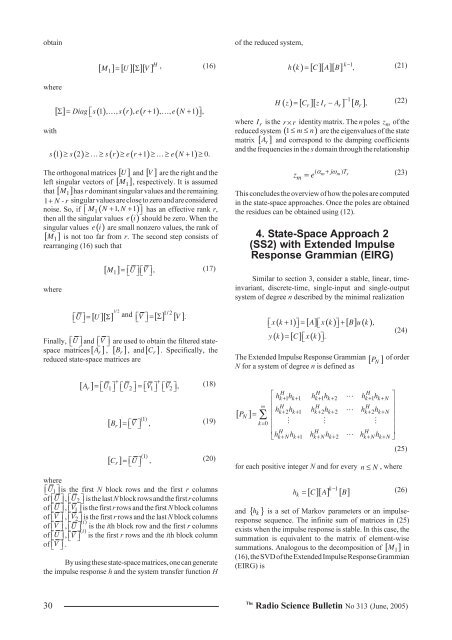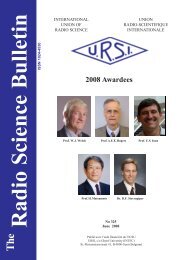obtainof the reduced system,wherewith[ M ] [ U][ ][ V]1H= Σ , (16)[] Σ = Diag ⎡s() ! s() r e( r + )!e( N + )⎣1, , , 1, , 1 ⎤⎦,() ( ) () ( ) ( )s 1 ≥ s 2 ≥…≥ s r ≥ e r+ 1 ≥…≥ e N + 1 ≥0.V are the right and the, respectively. It is assumed1 has r dominant singular values and the remaining1+ N -rsingular values are close to zero and are considerednoise. So, if ⎡⎣M1 ( N + 1, N + 1)⎤⎦ has an effective rank r,then all the singular values ei () should be zero. When thesingular values ei () are small nonzero values, the rank of[ M 1]is not too far from r. The second step consists ofrearranging (16) such thatThe orthogonal matrices [ U ] and [ ]left singular vectors of [ M 1]that [ M ]where[ ]M ⎣U⎦⎣V⎦1 = ⎡ ⎤⎡ ⎤,[ U][ ] 1/2and 1/2⎡V⎤=Σ[] [] V .⎡⎣U⎤= ⎦ Σ⎣⎦(17)Finally, ⎡⎣U⎤⎦ and ⎡ ⎣ V ⎤ ⎦ are used to obtain the filtered statespacematrices[ A r], [ B r], and[ C r]. Specifically, thereduced state-space matrices are[ A ] = ⎡U1⎤ ⎡U2⎤=⎡V1⎤ ⎡V2 ⎤ ,r+ +⎣ ⎦ ⎣ ⎦ ⎣ ⎦ ⎣ ⎦[ B ]r[ C ]r= ⎡⎣V⎤⎦= ⎡⎣U⎤⎦(1),(1),(18)(19)(20)where⎡⎣U 1 ⎤⎦is the first N block rows and the first r columnsof ⎡⎣U⎤⎦ , ⎡⎣U 2 ⎤⎦ is the last N block rows and the first r columnsof ⎡⎣U⎤⎦ , ⎡⎣V 1⎤⎦is the first r rows and the first N block columnsof ⎡⎣V⎤⎦ , V 2 ⎤⎦is the first r rows and the last N block columnsof ⎡⎣V⎤⎦ , () i⎡⎣U⎤⎦ is the ith block row and the first r columnsof ⎡⎣U⎤⎦ , () i⎡⎣V⎤⎦ is the first r rows and the ith block columnof ⎡⎣V⎤⎦ Ḃy using these state-space matrices, one can generatethe impulse response h and the system transfer function Hk() [ ][ ][ ] 1 ,h k = C A B −(21)−1() [ ][ ] [ ]H z = C zI − A B , (22)r r r rwhere I r is the r× r identity matrix. The n poles z m of thereduced system ( 1 ≤m≤ n)are the eigenvalues of the statematrix [ A r]and correspond to the damping coefficientsand the frequencies in the s domain through the relationship( m j m)Tsm = +(23)z e α ωThis concludes the overview of how the poles are computedin the state-space approaches. Once the poles are obtainedthe residues can be obtained using (12).4. State-Space Approach 2(SS2) with Extended ImpulseResponse Grammian (EIRG)Similar to section 3, consider a stable, linear, timeinvariant,discrete-time, single-input and single-outputsystem of degree n described by the minimal realizationx( k + ) = [ A] x() k + [ B] u()k() = [ ] ⎡ () ⎤.⎡⎣ 1 ⎤⎦ ⎡⎣ ⎤⎦,y k C ⎣x k ⎦The Extended Impulse Response Grammian [ P ]N for a system of degree n is defined as[ P ]NN(24)of order⎡ H H Hhk+ 1hk+ 1 hk+ 1hk+ 2 " hk 1h⎤+ k+N⎢⎥∞ H H H⎢hk+ 2hk+ 1 hk+ 2hk+ 2 " hk+ 2hk+N ⎥= ∑ ⎢ ⎥k=0 ⎢ # # # ⎥⎢ H H Hhk+ Nhk+ 1 hk+ Nhk+ 2 hk+ Nh⎥⎣" k+N⎦(25)for each positive integer N and for every n≤N , whereand { }kk−1[ ][ ] [ ]h = C A B(26)h k is a set of Markov parameters or an impulseresponsesequence. The infinite sum of matrices in (25)exists when the impulse response is stable. In this case, thesummation is equivalent to the matrix of element-wisesummations. Analogous to the decomposition of [ M 1]in(16), the SVD of the Extended Impulse Response Grammian(EIRG) is30The<strong>Radio</strong> <strong>Science</strong> <strong>Bulletin</strong> No <strong>313</strong> (<strong>June</strong>, <strong>2005</strong>)
whereH[ P ] [ U][ ][ V] ,N= Σ (27)[] Σ = Diag ⎡s() s( )! s() r e( r + )!e( N )with⎣1, 2, , 1, , ⎤⎦,() ( ) () ( ) ( )s 1 ≥ s 2 ≥…≥ s r ≥ e r + 1 ≥…≥e N ≥0.As noted earlier, the singular values { e( r + 1 ),!,e( N)}should be zero if the matrix [ P N ] has rank r, and the rankof [ P ] is approximately r when the remaining singularNvalues are very small. Definewhere [ ] j[ ]1 H( ) 4 1[] 4 [ ][ ] [ ][ ]X ≡ U Σ = Σ Ur≡ ⎡ , , ⎤,1 ⎢ ⎣⎥ ⎦2 r 1X ≡ ⎡ X , , X + ⎤,2 ⎢ ⎣⎥ ⎦1[ X] [ X] " [ X][ ] [ ] " [ ]H,(28)X is the jth column block of the matrixX truncated to the first r elements. Although the form of(27) is the same as (5) and (16), the decomposition in (28)differs from (18).In this case, the reduced state matrices [ A r], [ r]and [ C r]are given by[ A ] = [ X ][ X ]+ if and only if[ r][ ]r(1)2 1[ B ] [ X] 1 ,r1 2B ,A X = [ X] ,(29)= (30)−[ U][ ] 1/4 ,⎡C ⎣⎤=⎦Σ(31)[ C ]r(1),= ⎡C ⎣⎤(32)⎦where ⎡C ⎣⎤⎦is the ith block row of matrix [ C ] truncatedto the first r elements. If the reduced state-spacematrices[ A r], [ B r], and [ C r]are known, then the poles ofthe system can be extracted using the outlined procedure forSS1.5. Computation of Poles forTemporal Scattered FieldIn this study, the temporal back-scatteredelectromagnetic fields from five objects are used as impulseresponsesequences for the three direct-data-domain methods(MPM, SS1, SS2). To obtain the simulated scattered fieldsin the time domain, the frequency-domain back-scatteredfields are first calculated with WIPL-D [15], a method-ofmomentscode. WIPL-D uses an electric field integralequation (EFIE) for conducting structures and the PMCHW(Poggio-Miller-Chang-Harrington-Wu) Equation forcomposite structures. The time-domain data is calculatedby computing the inverse Fourier transform of the frequencydomainresult. Before taking the inverse Fourier transformof the frequency domain data, a Gaussian window is appliedto limit the bandwidth of the simulations.The advantages of the Gaussian window are two fold:(1) it provides a smooth roll off in time and frequency; and(2) it is well suited for numerical computation, as it generatesessentially band-limited frequency-domain data. Theexpression for this window in the time domain is [16]with()g t=σ1e2−a( − ),(33)ct ctγ = 0 .(34)σThe parameter c is the speed of light in free space, t 0 is atime delay that represents the peak time shift from theorigin, and σ is the pulse width that can be defined so thatthe peak value has dropped to about 2% at time t forct -ct0=± 2σ. Figure 1(a) shows an example of thetemporal Gaussian pulse, where σ = 1.0 and lm. The unitlm denotes a light meter, which is the length of time for anelectromagnetic wave to travel 1m. When the medium isfree space, 1lm = 3.33564ns. Since the Fourier transform ofa Gaussian function is Gaussian, the Fourier transform of(33) is( )πσ f 21 −( )c − j2πf t=0 (35)G f e ecand the frequency band corresponding to the pulse width isplotted in Figure 1(b).To illustrate the three fundamental data types (smooth,rapidly fluctuating, noise-like), five geometrically simpleobjects are analyzed: a thin conducting wire, a perfectlyconducting sphere, a perfectly conducting finite closedcylinder, a dielectric sphere, and a composite metallicdielectricsphere.5.1 Thin Conducting WireThe first example is a thin-wire scattering element of,The<strong>Radio</strong> <strong>Science</strong> <strong>Bulletin</strong> No <strong>313</strong> (<strong>June</strong>, <strong>2005</strong>) 31
- Page 1 and 2: Radio Science BulletinISSN 1024-453
- Page 3 and 4: EditorialJune in December?Yes, this
- Page 5 and 6: URSI Accounts 2004In 2004, a year p
- Page 7 and 8: EURO EUROA2) Routine Meetings 7,315
- Page 9 and 10: URSI AWARDS 2005The URSI Board of O
- Page 11 and 12: Guest Editors’ RemarksOn February
- Page 13 and 14: UWB and the corresponding signal pa
- Page 15 and 16: Radar / CommunicationsBand TypeElec
- Page 17 and 18: of the spectrum is required to comp
- Page 19 and 20: Bandwidths f l / GHz f h / GHz B F
- Page 21 and 22: Figure 3a. A time-domain representa
- Page 23 and 24: Bandwidths f l / f c f h / f c B F
- Page 25 and 26: Bandwidth f l / f c f h / f c B F C
- Page 27 and 28: Quantitative Comparison BetweenMatr
- Page 29: Next, construct the ‘filtered’
- Page 33 and 34: CPU Time [sec]250200150100MPMSS1SS2
- Page 35 and 36: -10-20MPMSS1SS2-30-40RMSE [dB]-50-6
- Page 37 and 38: RMSE [dB]-45-50-55-60-65-70MPMSS1SS
- Page 39 and 40: An Ultra-Compact Impulse-Radiating
- Page 41 and 42: Figure 3. UCIRA-1 splitter/balun.th
- Page 43 and 44: Figure 9. UCIRA-2 in stowed configu
- Page 45 and 46: activated first in the deployment s
- Page 47 and 48: Figure 20. Theoretical gain ofUCIRA
- Page 49 and 50: Triennial Reports CommissionsCOMMIS
- Page 51: y the Special Section Editors, and
- Page 55 and 56: 3.2 Activities of URSI-Commission C
- Page 57 and 58: It already has been decided that th
- Page 59 and 60: SCOR (Scientific Committee on Ocean
- Page 61 and 62: COMMISSION GThis triennium report w
- Page 63 and 64: GNSS-LEO occultation is a very impo
- Page 65 and 66: CPEA Contacts: Shoichiro Fukao, Pro
- Page 67 and 68: The group wishes to continue as an
- Page 69 and 70: total of 109 oral papers (24 thereo
- Page 71 and 72: surface, to compensate for the rema
- Page 73 and 74: XXVIIIth General AssemblyNEWLY ELEC
- Page 75 and 76: Décide1. d’accepter l’invitati
- Page 77 and 78: satellite observation, bottomside s
- Page 79 and 80: ETTC ‘05EUROPEAN TEST AND TELEMET
- Page 81 and 82:
IRI 2005 WORKSHOPNEW SATELLITE AND
- Page 83 and 84:
financial and logistics issues conn
- Page 85 and 86:
CONFERENCE ANNOUNCEMENTS36 TH COSPA
- Page 87 and 88:
December 2006APMC 2006 - 2006 Asia-
- Page 89 and 90:
The Journal of Atmospheric and Sola
- Page 91 and 92:
SCIENTIFIC COMMISSIONSCommission A
- Page 93 and 94:
Commission E : Electromagnetic Nois
- Page 95 and 96:
Commission J : Radio AstronomyChair
- Page 97 and 98:
URSI MEMBER COMMITTEESAUSTRALIA Pre
- Page 99 and 100:
ALPHABETICAL INDEX AND CO-ORDINATES
- Page 101 and 102:
BRUSSAARD, Prof. dr.ir. G., Radicom
- Page 103 and 104:
FEICK, Dr. R., Depto. de Electronic
- Page 105 and 106:
SAUDI ARABIA, Tel. +966 1-4883555/4
- Page 107 and 108:
E-mail loulee@nspo.gov.tw (94)LEE,
- Page 109 and 110:
O’DROMA, Dr. M., Dept. of Electri
- Page 111 and 112:
+30 2310 998161, Fax +30 2310 99806
- Page 113 and 114:
TURSKI, Prof. A., ul. Krochmalna 3
- Page 115 and 116:
Information for authorsContentThe R
















